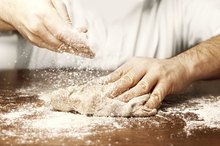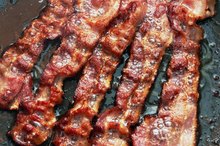Foods Containing Potassium Nitrate
According to the Food Standards Agency, potassium nitrate is a orthorhombic crystal compound found commonly in explosives, fireworks, rocket propellants, fertilizers and tree stump removers 1. Yet, since the medieval ages, potassium nitrate, also called salt peter, has been used to preserve meats. In historical times, potassium nitrate was made using a combination of straw and urine. Now, more sophisticated measures, which do not involve the use of bodily substances, are used in its creation. Potassium nitrate is a partially effective food preservative that is more frequently used to cure and smoke meats.
Corned Beef
To create that vibrant red color that distinguishes corned beef, potassium nitrate is added to the brine along with the pickling spices. Compare this to the old fashioned corned beef, which was brined in salt water for around a week and is a grayish pink color. Federal regulations limit the amount of potassium nitrate that can be added to brine to 2 lbs. per 100 gallons of the corned beef brine, according to the University of Minnesota.
- To create that vibrant red color that distinguishes corned beef, potassium nitrate is added to the brine along with the pickling spices.
- Compare this to the old fashioned corned beef, which was brined in salt water for around a week and is a grayish pink color.
Cured Salami
Sodium Nitrite & Cancer
Learn More
The Oregon State University explains that the characteristic pink hue of cooked salami is due to the presence of the potassium nitrate. The nitrate portion of the salt peter not only protects the color of the fresh meat, but also adds more pink pigment due to the reaction of the nitrate with the protein in the meat.
Cured Ham
The National Center for Home Food Preservation explains that one of the major curing ingredients is nitrate, which can be obtained from potassium nitrate or sodium nitrate. U.S. Food and Drug Administration guidelines limit the amount of potassium nitrate to 2.75 oz. per 100 lbs. of chopped ham.
- The National Center for Home Food Preservation explains that one of the major curing ingredients is nitrate, which can be obtained from potassium nitrate or sodium nitrate.
Related Articles
References
- "Expert Group on Vitamins and Minerals"; Risk Assessment: Potassium; Food Standards Agency; 2003
Resources
Writer Bio
Writing professionally since 1998, Dr. Christine Princeton has been published with the American Osteopathic Association and the Society for Teachers of Family Medicine. Dr. Princeton received her degree at Touro University Nevada College of Osteopathic Medicine and works as a physician in the fields of hospital medicine and women's health.









